 |
| Social Life: Women |
|
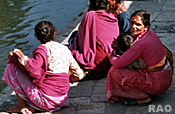 |
 |
| Efforts at Promotion of Women in Nepal |
| Book Review: "Efforts at Promotion of Women in Nepal" |
| INTRODUCTION |
| BOOK CONTENTS | ABBREVIATIONS | ||||||||||||||||||||||
|
|
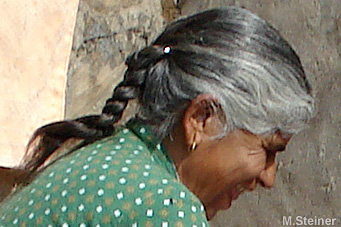 |
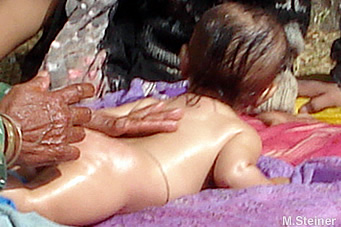 |
|
|
| Foreword |
|
|
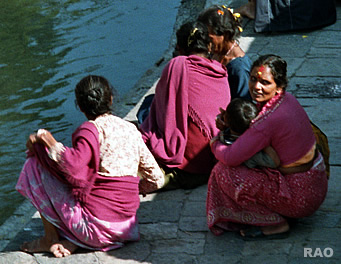 |
|
The government of Nepal has legislated several provisions in consonance with international obligations aiming to enhance the role of women in governance and development.
The
recent Reform Agendas set by the government and opposition forces for national
reconciliation forcefully articulate the concept of both gender and inter-generational
justice and promise to create favorable conditions in promoting their life,
liberty, property, and identity.
Sustaining the capacities for democratic governance in the nation, however, requires the re-socialization and self-organisation of people, both male and female, to redefine their role, solve collective problems, achieve common good, and resolve conflicts. The institutional foundation of democracy becomes strong if women, half of the nation's population, equally wield the power to make choice and project their visibility and voice in the process of decision-making. Democracy offers the best possible prospect for the reconstruction of a sovereign citizenship.
This study "Efforts at Promotion of Women in Nepal" by Dr. Meena Acharya fully updates the social, economic, and political status of women in Nepal, the achievements the country has made so far, and the tasks lying ahead. It also formulates fundamental questions about how FES as a democratic foundation can proceed in helping to promote the social and political integration of men and women in partner NGOs, educational institutions, trade unions, media, and civil society. We hope, this study initiated by Samira Paudel and edited in the final version by Anand Aditya will help the academic community, policy makers, and the attentive public in better understanding the situation of women in Nepal and to formulate a just and gender-sensitive order of knowledge building, policy innovation, and activities.
Dev Raj Dahal
Friedrich-Ebert-Stiftung (FES)
Ram Hari Sharma
Tanka Prasad Acharya Memorial Foundation
| I Introduction |
|
|
This analysis takes change in gender relations as the primary objective of all policies, strategies, and programs directed at women's development. Women have always constituted about half of the population and the fact that a society can not advance without their moving forward along with men has been recognized from the beginning of planned development. Nevertheless, initially women were viewed as a welfare issue as all human development issues were. Spending on education, health, and other social items was categorized as welfare expenditure as was the expenditure on improving women's access to such services. This was the first phase of attention to women's needs. They were viewed just as consumers and mothers and wives. Their well-being and education were considered necessary primarily because they were mothers and companions to men.
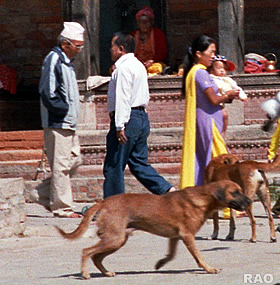 |
|
Then, WID evolved into the concept of Women and Development (WAD), which emphasized that women were not outside the development process and they were integrated in development in an exploitative relation. They were supporting the process of capitalistic development by freeing it from the need of paying adequate subsistence wages to its workers to support their families. However, the WAD approach paid little attention to the patriarchal relations within the domestic and public arena, often reinforced by the developing capitalist structures.
All these concepts emphasized women's position in relation to development and not her overall position in the society. In spite of much rhetoric during the two decades following 1975, the changes realized in women's status and rights, particularly in developing countries, were marginal. After a review of the progress made in advancing women's cause, the Beijing Platform for Action (1995) proposed a 12-point program. The distinguishing feature of this Platform compared to earlier programs was its emphasis on the multi-dimensional nature of women's subordination and the need to attack it in all spheres by mainstreaming and empowerment of women. It adopted a gender framework for the analysis and solution to women's problems and adopted an Action Plan, emphasizing 12 focus areas as follows:
1.
Women and Poverty
2.
Education and Training for women
3.
Women and health
4.
Violence against women
5.
Women and armed conflict
6.
Women and the economy
7.
Women in power and decision-making
8.
Institutional mechanisms for advancement of women
9.
Human rights of women
10.
Women and the media
11.
Women and the environment
12.
The girl child
In Nepal, the move to WID, WAD, and Gender approaches to development (GAD) has not been uniform in all the sectors and civil society institutions. In principle the government/donors and some INGOs and women-specific National-level NGOs have moved faster in this direction. Other civil society institutions such as media, trade unions, and local NGOs seem still to be grappling with the WAD approach. Before embarking on the analysis of such moves of various sectors, it seems only appropriate to provide some clarifications on the concept of gender and gender approach to development.
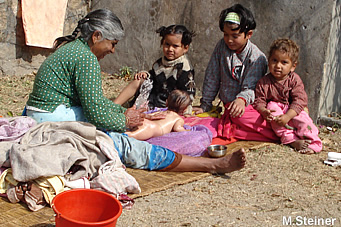 |
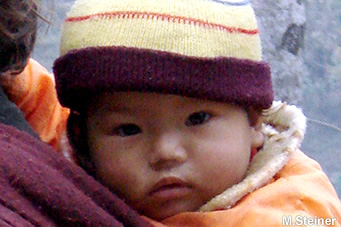 |
| II Understanding the Gender Concepts: A Framework for Analysis |
|
|
Gender approach to women's advancement is different from WID or WAD in that it recognizes the multi-dimensional nature of women's subordination. Particularly it assumes that:
![]() Women as physical beings are different from the "female" as presumed by
the society. While women as physical beings are universally the same with
the exclusive responsibility of physical reproduction of human beings,
as cultural beings "females" are context-specific, changing with time and
context. How should they dress, how should they behave and what type of
work they can do and what they cannot is very time- and context- specific.
For example, as per the standard of decency of female dress, while in the
west exposing your legs is allowed, exposing midriff is not. The reverse
is true in South Asia. While blouse lengths worn with saris can go all
the way up to just covering breasts, legs cannot be exposed. Within Nepal
itself, while women have to exile themselves from the house-premises to
inhabitable animal shades during their monthly periods in the western part
of the country, women in other parts do not have to bear this extreme form
of indignity against their human rights to live safely. Innumerable examples
can be cited of such variation in gendered images and standards. Similarly,
with the demise of the land-based feudal society in the west, women do
not have to be compulsorily transferred to a final household. They have
a choice to live by themselves or with either of the natal or a final household.
Most of the time older parents are taken care of by daughters rather than
the sons. In Nepal, in principle, women have to live with their husband's
family, while in practice they could be living with either of the children,
male or female (speci-fically for the South Asian Context, see Bhasin,
2000 and Bhasin and Khan, 1991).
Women as physical beings are different from the "female" as presumed by
the society. While women as physical beings are universally the same with
the exclusive responsibility of physical reproduction of human beings,
as cultural beings "females" are context-specific, changing with time and
context. How should they dress, how should they behave and what type of
work they can do and what they cannot is very time- and context- specific.
For example, as per the standard of decency of female dress, while in the
west exposing your legs is allowed, exposing midriff is not. The reverse
is true in South Asia. While blouse lengths worn with saris can go all
the way up to just covering breasts, legs cannot be exposed. Within Nepal
itself, while women have to exile themselves from the house-premises to
inhabitable animal shades during their monthly periods in the western part
of the country, women in other parts do not have to bear this extreme form
of indignity against their human rights to live safely. Innumerable examples
can be cited of such variation in gendered images and standards. Similarly,
with the demise of the land-based feudal society in the west, women do
not have to be compulsorily transferred to a final household. They have
a choice to live by themselves or with either of the natal or a final household.
Most of the time older parents are taken care of by daughters rather than
the sons. In Nepal, in principle, women have to live with their husband's
family, while in practice they could be living with either of the children,
male or female (speci-fically for the South Asian Context, see Bhasin,
2000 and Bhasin and Khan, 1991).
![]() Gender relations are the result of socially cons-tructed unequal power
relations and are context-specific. There is nothing in women's reproductive
responsibilities that should make them subordinate to men. It is the culture
which establishes the ideology of male supremacy and female subordination.
Without repro-duction the human race cannot survive and the position of
motherhood is exalted in all cultures. But female subordi-nation at this
stage of human history is universal, although its form and degree vary
from society to society. How and when this started is still controversial.
Some feminists ascribe it to the invention of agriculture, others to the
need for continuous physical defense for survival in the hunting societies
and women and children's specific need for such protection during pregnancy
and lactation (for a summary of the debate, see Rosaldo and Lamphere, 1974;
Krishnaraj, no dates; Tong, 1989). Starting with Engels (1977), the Marxists
in general and the Marxist feminists believe it to be a product of class
society, originating with private property.
Gender relations are the result of socially cons-tructed unequal power
relations and are context-specific. There is nothing in women's reproductive
responsibilities that should make them subordinate to men. It is the culture
which establishes the ideology of male supremacy and female subordination.
Without repro-duction the human race cannot survive and the position of
motherhood is exalted in all cultures. But female subordi-nation at this
stage of human history is universal, although its form and degree vary
from society to society. How and when this started is still controversial.
Some feminists ascribe it to the invention of agriculture, others to the
need for continuous physical defense for survival in the hunting societies
and women and children's specific need for such protection during pregnancy
and lactation (for a summary of the debate, see Rosaldo and Lamphere, 1974;
Krishnaraj, no dates; Tong, 1989). Starting with Engels (1977), the Marxists
in general and the Marxist feminists believe it to be a product of class
society, originating with private property.
![]() But there is now general consensus that the human society must advance
towards an equitable society in general and gender equality in particular.
The unequal gender relations must recede along with all other inequalities.
Still, in the name of culture, tradition, and religion the goal of gender
equality is interpreted differently in different societies. Often it becomes
necessary to reiterate that the end of inequities does not mean that women
want to be like men and get rid of their mothering responsibilities. It
only means the social, political, and economic inequities based on their
different role in reproduction of human beings must end. They must have
a choice in all the walks of life on an equal footing with men. Why is
it that cooking in the restaurant becomes a male job and is considered
work while the same work done by women at home is defined as no work? Why
is it that men farming their own land are considered economically active
while women laboring day and night in the family fields are considered
non-economic in the conventional economics? Such inconsistencies and socially
defined inequities exist in all walks of life and must be redressed.
But there is now general consensus that the human society must advance
towards an equitable society in general and gender equality in particular.
The unequal gender relations must recede along with all other inequalities.
Still, in the name of culture, tradition, and religion the goal of gender
equality is interpreted differently in different societies. Often it becomes
necessary to reiterate that the end of inequities does not mean that women
want to be like men and get rid of their mothering responsibilities. It
only means the social, political, and economic inequities based on their
different role in reproduction of human beings must end. They must have
a choice in all the walks of life on an equal footing with men. Why is
it that cooking in the restaurant becomes a male job and is considered
work while the same work done by women at home is defined as no work? Why
is it that men farming their own land are considered economically active
while women laboring day and night in the family fields are considered
non-economic in the conventional economics? Such inconsistencies and socially
defined inequities exist in all walks of life and must be redressed.
![]() Patriarchy is an overarching ideology which pervades all aspects of social
existence. Women's subordination is all round - economic, social, religious,
cultural, political, and ideological, each of which reinforces the other
one. For example, in our culture dominated by Hindu ideology, subordination
of women to men is fortified at the primary level by transferring her inheritance
rights to her a final household on the one hand and making it conditional
on her sexual behavior on the other. Thus her culturally created economic
vulnerability is reinforced by the control of afinal household over her
sexuality. Her transfer to a final household is made into a cultural tradition
reinforced by the religious code of conduct for married women to submerge
her identity into the identity of her husband. Her Gotra itself changes
with marriage. She becomes an integral part of the afinal clan and is completely
excluded from the natal clan. She has no individual identity, socially,
religiously, or legally and has only derived access to property and social
status. Therefore the efforts to liberate women from the oppressive gender
rela-tions must be all round.
Patriarchy is an overarching ideology which pervades all aspects of social
existence. Women's subordination is all round - economic, social, religious,
cultural, political, and ideological, each of which reinforces the other
one. For example, in our culture dominated by Hindu ideology, subordination
of women to men is fortified at the primary level by transferring her inheritance
rights to her a final household on the one hand and making it conditional
on her sexual behavior on the other. Thus her culturally created economic
vulnerability is reinforced by the control of afinal household over her
sexuality. Her transfer to a final household is made into a cultural tradition
reinforced by the religious code of conduct for married women to submerge
her identity into the identity of her husband. Her Gotra itself changes
with marriage. She becomes an integral part of the afinal clan and is completely
excluded from the natal clan. She has no individual identity, socially,
religiously, or legally and has only derived access to property and social
status. Therefore the efforts to liberate women from the oppressive gender
rela-tions must be all round.
![]() Men also are victims of patriarchal ideology, but to a lesser degree. For
example, the image of masculinity deprives them from simple human qualities
such as empathy, kindness, and sensitiveness and the natural expression
of their pain, weeping. While family should be a joint venture where each
member contributes as per her/his ability and derives benefits according
to her/his needs, women are forced to limit themselves within the household
while men are forced to earn the living. Ideologically, to use a wife's
or a daughter's income for family survival is a dishonor for the husband/
father, but in practice, men do not hesitate to kill their wives for dowry.
Such inconsistencies are gene-rated by the unnatural social rules and behavioral
expectations imposed on men and women. Girls are raised to depend on husbands
for access to resources not to earn independent income and for the boys
it is made an act of honor not to let their wives work. Still they want
money for marrying a girl, defying all principles.
Men also are victims of patriarchal ideology, but to a lesser degree. For
example, the image of masculinity deprives them from simple human qualities
such as empathy, kindness, and sensitiveness and the natural expression
of their pain, weeping. While family should be a joint venture where each
member contributes as per her/his ability and derives benefits according
to her/his needs, women are forced to limit themselves within the household
while men are forced to earn the living. Ideologically, to use a wife's
or a daughter's income for family survival is a dishonor for the husband/
father, but in practice, men do not hesitate to kill their wives for dowry.
Such inconsistencies are gene-rated by the unnatural social rules and behavioral
expectations imposed on men and women. Girls are raised to depend on husbands
for access to resources not to earn independent income and for the boys
it is made an act of honor not to let their wives work. Still they want
money for marrying a girl, defying all principles.
![]() Since patriarchy is an overwhelming ideology, which pervades all aspects
of social existence, women's problems cannot be solved just by addressing
her basic needs issues, such as access to minimum of food, shelter, drinking
water, primary education, primary health care, and freedom from violence.
Issue of power relations must also be addressed.
Since patriarchy is an overwhelming ideology, which pervades all aspects
of social existence, women's problems cannot be solved just by addressing
her basic needs issues, such as access to minimum of food, shelter, drinking
water, primary education, primary health care, and freedom from violence.
Issue of power relations must also be addressed.
![]() Women's overall socio-political and economic status can be improved only
by changing the gender relations of domination and subordination between
men and women that is by empowerment of women. Empowerment is an all-comprehensive
process, which is difficult to define in concrete terms. One way to define
it could be "the process of gaining control over the self, over ideo-logy
and the resources which determine power" (see Batliwala, 1994). "This must
be a multi-dimen-sional process encompassing all aspects of social existence,
legal rights, guarantee of equity, and equality in access to resources,
education, and knowledge as also generation of a consciousness about and
a willingness to fight against the oppressive relations.
Women's overall socio-political and economic status can be improved only
by changing the gender relations of domination and subordination between
men and women that is by empowerment of women. Empowerment is an all-comprehensive
process, which is difficult to define in concrete terms. One way to define
it could be "the process of gaining control over the self, over ideo-logy
and the resources which determine power" (see Batliwala, 1994). "This must
be a multi-dimen-sional process encompassing all aspects of social existence,
legal rights, guarantee of equity, and equality in access to resources,
education, and knowledge as also generation of a consciousness about and
a willingness to fight against the oppressive relations.
It must "address all structures of power." The end product of empowerment is develop-ment of an individual, who is self-confident, understands the processes of social interaction, economic resource allocation, and has power to decide and also sufficient options to be able to choose where one wants to work and how one wants to live. Empowerment also means having voice and influence over economic and political decisions affecting their lives in the larger arena. While economic and social empowerments are necessary conditions for attaining the position of political power, political power enhances the opportunities for economic and social empowerment. This process must contribute to women's real empowerment in all its dimensions. It is not sufficient just to increase women's income by a marginal amount and help them gain a greater role in the household decision making process, while the role of the household itself in the economic and political processes effecting the lives of the people may be declining. In this context, the empowerment process may be viewed in terms of the following three dimensions:
![]() Increasing women's political power through women's organisations, solidarity,
and collective action. Both qualitative and quantitative indicators may
be used to evaluate this process. Political ability to bring about changes
in women's legal status, to direct resources to women, and to get access
to positions of power is of crucial importance.
Increasing women's political power through women's organisations, solidarity,
and collective action. Both qualitative and quantitative indicators may
be used to evaluate this process. Political ability to bring about changes
in women's legal status, to direct resources to women, and to get access
to positions of power is of crucial importance.
![]() Increasing women's access to economic opportunities and resources relative
to men, such as employment, credit, and wealth including land and technology
and apparently non-economic resources such as education, knowledge, and
health which are basic to human development.
Increasing women's access to economic opportunities and resources relative
to men, such as employment, credit, and wealth including land and technology
and apparently non-economic resources such as education, knowledge, and
health which are basic to human development.
![]() Raising social consciousness of women and men about the symptoms and causes
of the oppressive religious, economic, cultural, familial, and legal practices;
chang-ing the perceived social images of women as indivi-duals; strengthening
their capacity to take action for changing the gender roles.
Raising social consciousness of women and men about the symptoms and causes
of the oppressive religious, economic, cultural, familial, and legal practices;
chang-ing the perceived social images of women as indivi-duals; strengthening
their capacity to take action for changing the gender roles.
![]() Thus gender assessment of the institutions and programs must evaluate all
structures, policies, programs/projects etc whether they are gender-sensitive
and conducive to empowerment of women. Gender sensitiveness may be viewed
in terms of strength and effectiveness of the specific machinery involved
in advocating women's concerns in the development process, gender awareness
of the general implementing machinery, and finally, proportion of women
in decision making roles in the government.
Thus gender assessment of the institutions and programs must evaluate all
structures, policies, programs/projects etc whether they are gender-sensitive
and conducive to empowerment of women. Gender sensitiveness may be viewed
in terms of strength and effectiveness of the specific machinery involved
in advocating women's concerns in the development process, gender awareness
of the general implementing machinery, and finally, proportion of women
in decision making roles in the government.
![]() This means it is not adequate to just involve women in development programs/projects;
measures to empower them and changing the gender relations must be incorpo-rated
and implemented in all programs/ projects.
This means it is not adequate to just involve women in development programs/projects;
measures to empower them and changing the gender relations must be incorpo-rated
and implemented in all programs/ projects.
![]() Women cannot be viewed as objects of development; they must be viewed as
subjects of development. For example, it is often argued that women must
be involved in programs to increase the efficiency and effectiveness of
the programs. Although UNDP long since has taken a people-focused approach
to development, putting people at the center, the largest development agency,
the World Bank, still views the need for involving stakeholders in general
and women in particular in development programs primarily for increasing
the efficiency of its development interventions (World Bank, 2001). But
equality and equity is a woman's human right and they must benefit from
human progress on an equal footing with men.
Women cannot be viewed as objects of development; they must be viewed as
subjects of development. For example, it is often argued that women must
be involved in programs to increase the efficiency and effectiveness of
the programs. Although UNDP long since has taken a people-focused approach
to development, putting people at the center, the largest development agency,
the World Bank, still views the need for involving stakeholders in general
and women in particular in development programs primarily for increasing
the efficiency of its development interventions (World Bank, 2001). But
equality and equity is a woman's human right and they must benefit from
human progress on an equal footing with men.
![]() Gender approach to development (GAD) also means that all other kinds of
oppression, besides gender relations, for example, caste, class, ethnicity,
language-related inequalities must also be addressed simultaneously. When
there is any kind of inequity in the society, women are oppressed doubly
as women and as members of the disadvantaged group. For example dalit or
poor women are more intensely exploited by the men of upper caste and also
by their own men. Many more dalit women are raped with social immunity
than women from upper castes or richer economic strata. The gender dispa-rity
in access to education and health facilities among the dalits exists at
a more intensive level than among the non-dalits.
Gender approach to development (GAD) also means that all other kinds of
oppression, besides gender relations, for example, caste, class, ethnicity,
language-related inequalities must also be addressed simultaneously. When
there is any kind of inequity in the society, women are oppressed doubly
as women and as members of the disadvantaged group. For example dalit or
poor women are more intensely exploited by the men of upper caste and also
by their own men. Many more dalit women are raped with social immunity
than women from upper castes or richer economic strata. The gender dispa-rity
in access to education and health facilities among the dalits exists at
a more intensive level than among the non-dalits.
![]() Women's needs and problems are too colossal to be addressed by individual
programs. They have to be addressed in all spheres, hence the concept of
main-streaming. Since women's problems were viewed as some-thing different
from the overall society under WID and WAD, specific programs for women
were advocated. Under the mainstreaming approach, the emphasis is on all
poli-cies, programs/projects, sector-specific or otherwise. They must be
gender/ class/caste/ethnicity-sensitive and must try to redress the disadvantages
faced by women of each group in each of the sphere. It does not mean that
the basic needs-related programs are to be neglected. But it means that
they are not adequate. Basic needs-related programs can be very effective
if implemented in addition to programs which meet women's strategic needs,
as defined below. In addition, capacity building and compensating programs
are also a must so that women can benefit from gender-neutral programs
on an equal footing with men. Further, women's specific needs related to
their reproduc-tive and mothering functions and combating various forms
of violence against them must also be addressed. To capture these complexities
in program analysis some analytical concepts may be useful as discussed
below:
Women's needs and problems are too colossal to be addressed by individual
programs. They have to be addressed in all spheres, hence the concept of
main-streaming. Since women's problems were viewed as some-thing different
from the overall society under WID and WAD, specific programs for women
were advocated. Under the mainstreaming approach, the emphasis is on all
poli-cies, programs/projects, sector-specific or otherwise. They must be
gender/ class/caste/ethnicity-sensitive and must try to redress the disadvantages
faced by women of each group in each of the sphere. It does not mean that
the basic needs-related programs are to be neglected. But it means that
they are not adequate. Basic needs-related programs can be very effective
if implemented in addition to programs which meet women's strategic needs,
as defined below. In addition, capacity building and compensating programs
are also a must so that women can benefit from gender-neutral programs
on an equal footing with men. Further, women's specific needs related to
their reproduc-tive and mothering functions and combating various forms
of violence against them must also be addressed. To capture these complexities
in program analysis some analytical concepts may be useful as discussed
below:
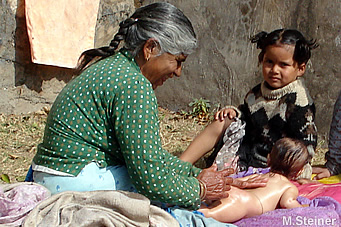 |
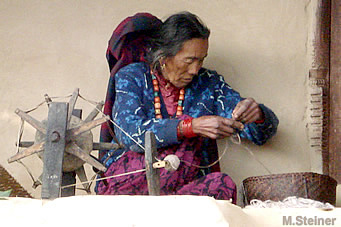 |
![]() Basic and strategic needs: Although such needs overlap and many programs
can fulfill both kinds of needs, it is useful to separate them for analytical
purposes. Basic needs include access to minimum environment for survival
such as access to income, drinking water, health facilities, education,
and free-dom from violence etc. Strategic needs include her need for changes
in division of labor, power structures, freedom of mobility and choice
of livelihood options, control over resources etc. Programs directed to
meet-ing women's strategic needs must incorporate efforts to change the
oppressive socio-economic and political structures, acts, rules, regulation
and oppressive ideology of all kinds.
Basic and strategic needs: Although such needs overlap and many programs
can fulfill both kinds of needs, it is useful to separate them for analytical
purposes. Basic needs include access to minimum environment for survival
such as access to income, drinking water, health facilities, education,
and free-dom from violence etc. Strategic needs include her need for changes
in division of labor, power structures, freedom of mobility and choice
of livelihood options, control over resources etc. Programs directed to
meet-ing women's strategic needs must incorporate efforts to change the
oppressive socio-economic and political structures, acts, rules, regulation
and oppressive ideology of all kinds.
![]() Relief-oriented, gender reinforcing or equality pro-moting programs: Relief-oriented
programs address only disadvantages arising out of temporary disasters,
such as floods, earthquake, drought, violence etc. Such programs deal only
with the results of structural problems and do not question the traditional
gender roles. For example, the widow pension, does not address the basic
issue of ensuring property rights of women, but treats only the results.
Similarly, the micro-credit programs, widely in vogue, have been designed
to fit the traditional roles of women. They do not empower women or provide
a better ground for equality directly, but indirectly they do strengthen
women's self-confidence and capacity for collective action.
Relief-oriented, gender reinforcing or equality pro-moting programs: Relief-oriented
programs address only disadvantages arising out of temporary disasters,
such as floods, earthquake, drought, violence etc. Such programs deal only
with the results of structural problems and do not question the traditional
gender roles. For example, the widow pension, does not address the basic
issue of ensuring property rights of women, but treats only the results.
Similarly, the micro-credit programs, widely in vogue, have been designed
to fit the traditional roles of women. They do not empower women or provide
a better ground for equality directly, but indirectly they do strengthen
women's self-confidence and capacity for collective action.
Many programs could also be gender reinforcing whereby the gender roles are not questioned and there is no attempt made to change them. Gender reinforcing schemes assist women in their traditionally accepted standard gender functions, e.g., maternity and child care programs, family planning, access to drinking water, nurse training, home-based employment schemes etc. In home-based employment schemes, the logic is that women will have to adjust with their household responsibilities. But, nobody questions why they have to adjust and why men do not need to adjust.
Equality
promoting programs, on the other hand, are targeted for canceling the handicaps
that women have because they are women or because they have children, e.g.,
uniforms for school girls, provision of neighborhood schools or girls'
toilets in schools or working women's hostels. The above categories are
not water-tight, but are useful for a meaningful gender analysis of the
programs and budgetary allocations.
![]() Stepwise criteria that could be adopted for the appraisal of programs are:
Stepwise criteria that could be adopted for the appraisal of programs are:
![]() Women's involvement:
Women's involvement:
Since participation is a necessary condition for empowerment,
women's involvement at various stages of program imple-mentation itself
should be taken as a positive change. But to decide whether it is empowering
as well, we need to examine the degree and quality of their involvement,
which includes their role in the decision making process, planning, programming,
control over the use of resources etc.
![]() Women's employment opportunities:
Women's employment opportunities:
Does
the program increase work opportunities for the poorer sections of the
population, particularly women/men from the poorer households? This will
help to fulfill their basic needs. Once again the quality of employment
and the issue of gender discrimination or equity in employment conditions
need to be examined to decide whether they are reinforcing gender roles
or not. Only equitable access of women to decision making roles may be
considered empowering.
![]() Impact on women's workload:
Impact on women's workload:
Does
the project activity reduce women's drudgery and workload? Additional roles
for women, without an effort to change the traditional gender roles and
technology at home; generally increases workload of women, while relieving
men even from their traditional responsibilities as well. This makes the
gender roles more inequitable.
![]() Whether Empowering or Equality Promoting:
Whether Empowering or Equality Promoting:
Programs
empowering for women are expected to enable women to participate more in
decisions making process both within and outside their households. They
are also expected to generate direct benefit from the activities in terms
of income, health, education, access to resources etc, and promote equality.
| III Development Plans and Policies (1980/81- 2002/3) in Nepal |
|
|
The
Government Sector /Donor Policies and Programs
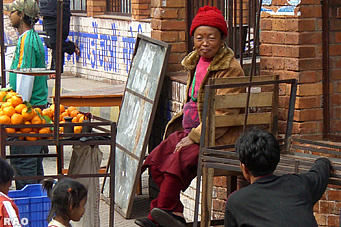 |
|
The Seventh and the Eighth Five Year Plans expanded on these themes. Required legal reforms were also to be implemented to facilitate women's participation in development. The Eighth Plan also mentioned the issue of increasing women's representation at decision making levels in the government, non-government, and semi-government sectors and developing a monitoring system for recording gender discrimination at work. A suitable organisational structure for coordination and monitoring of activities relating to women was also envisaged.
At the National level, the government policies have moved with the international thinking, initiating programs for women with a welfare approach, particularly in education and health, emphasi-zing their mothering roles during the sixties and seventies and adopting a WID approach with emphasis on their developmental role during the eighties. The government had emphasized women's involvement in all programs and projects, recognized legal impe-diment to their economic empowerment, and enunciated special programs for meeting their needs already in the Sixth Five Year Plan (1981-1985).
The Seventh and the Eighth Five Year Plans expanded on these themes. Required legal reforms were also to be implemented to facilitate women's participation in development. The Eighth Plan also mentioned the issue of increasing women's representation at decision making levels in the government, non-government, and semi-government sectors and developing a monitoring system for recording gender discrimination at work. A suitable organisational structure for coordination and monitoring of activities relating to women was also envisaged.
Specifically, the Ninth Plan (1997-2002) adopted main-streaming, eliminating gender inequality, and empowerment as its major strategies for women's advancement and thus moved towards a gender approach to women's promotion.
Mainstreaming was further explained as clearly defined policies, targets, and programs in all sectors at the national and regional levels, more scientific and realistic calculation of GDP statistics to include women's contributions therein, and development of more effective coordination and monitoring instruments and mechanisms.
The objective of equality was decomposed into elimination of gender inequality in all laws, affirmative action policies and programs to reduce current inequality in economic social and other areas, stronger laws and enforcement mechanisms to counter all kinds of violence against women and gender awareness programs for the public sector institutions.
Empowerment, on the other hand, included mandatory repre-sentation of women in the formulation of policies and programs at all levels; ensuring women's rights in ownership of land, agricul-tural training, marketing, and other income generating activities; development of a better health system to ensure wider access to qualitatively improved facilities for safe motherhood, delivery etc; continuation of specific enabling programs in education, technical, entrepreneurial, and management training; increasing access to institutional credit, other resources and assets for income genera-tion; promotion of technological improvements in agriculture and other fields so as to reduce drudgery of women's work and to increase their productivity.
Accordingly, achievements since 1981 include:
![]() Establishment of a number of institutions, including a Ministry of Women,
Children and Social Welfare (MWCSW) in 1995, divisions in National Planning
Commission (NPC), and Ministries of Agriculture and Education and a Women's
Commission, although only by Cabinet decision and not as an institution
independent from the executive.
Establishment of a number of institutions, including a Ministry of Women,
Children and Social Welfare (MWCSW) in 1995, divisions in National Planning
Commission (NPC), and Ministries of Agriculture and Education and a Women's
Commission, although only by Cabinet decision and not as an institution
independent from the executive.
![]() Institution of gender-focal persons in many of the ministries, including
Health, MLD, Finance, Labor, Industry etc.
Institution of gender-focal persons in many of the ministries, including
Health, MLD, Finance, Labor, Industry etc.
![]() Increase in women's participation in sector programs, such as farmer trainings,
forestry groups, and skill trainings to about 20 percent.
Increase in women's participation in sector programs, such as farmer trainings,
forestry groups, and skill trainings to about 20 percent.
![]() Initiation of specific programs for women which include
Initiation of specific programs for women which include
![]() Large national level credit programs such as Produc-tion Credit for Rural
Women (PCRW) and Micro-Credit Project for Women (MCPW), Women's Develop-ment
Program under Small Farmer Development Program, five regional banks (Regional
Rural Development Banks) in the government sector and People's Banks like
Nirdhan and Center for Social Development Banks, which evolved from small
NGOs and operate along the Bangladesh Grameen Bank model, lending only
to women's groups and owned largely by the members/clients.
Large national level credit programs such as Produc-tion Credit for Rural
Women (PCRW) and Micro-Credit Project for Women (MCPW), Women's Develop-ment
Program under Small Farmer Development Program, five regional banks (Regional
Rural Development Banks) in the government sector and People's Banks like
Nirdhan and Center for Social Development Banks, which evolved from small
NGOs and operate along the Bangladesh Grameen Bank model, lending only
to women's groups and owned largely by the members/clients.
![]() Educational programs such as special provisions for female teachers, scholarships
for girls etc.
Educational programs such as special provisions for female teachers, scholarships
for girls etc.
![]() Setting concrete targets for reduction of maternal mortality rate (MMR)
and morbidity-related deficien-cies.
Setting concrete targets for reduction of maternal mortality rate (MMR)
and morbidity-related deficien-cies.
![]() Extension of health facilities, health information and education to increase
the access of women and children to primary health care, immunization,
nutrition, iron and vitamin A supplements etc.
Extension of health facilities, health information and education to increase
the access of women and children to primary health care, immunization,
nutrition, iron and vitamin A supplements etc.
![]() Legal reform making women's right to property a little more secure and
strengthening punitive measures against violence. The amendment to the
Mulki Ain (Law of the Land) established unmarried daughters as co-parsons
in the parental property and encoded her right to be supported and educated
on par with her brothers. It also established her as a co-parson in her
husband's property immediately after marriage as she loses her right to
parental property on marriage. Previously daughters had to remain unmarried
up to 35 years to be entitled to a share in the parental property and remain
unmarried through life to maintain her full right over it. In the afinal
household also she had to have been married for 15 years and be of 35 years
of age for independent right in her husband's property.
Legal reform making women's right to property a little more secure and
strengthening punitive measures against violence. The amendment to the
Mulki Ain (Law of the Land) established unmarried daughters as co-parsons
in the parental property and encoded her right to be supported and educated
on par with her brothers. It also established her as a co-parson in her
husband's property immediately after marriage as she loses her right to
parental property on marriage. Previously daughters had to remain unmarried
up to 35 years to be entitled to a share in the parental property and remain
unmarried through life to maintain her full right over it. In the afinal
household also she had to have been married for 15 years and be of 35 years
of age for independent right in her husband's property.
The Tenth Plan (2002-2007) continues this emphasis on mainstreaming, equality, and empowerment while trying to address the major problems related to internalization of these strategies in sector policies and programs. The major problems identified in implementation of these strategies during the Ninth Plan were:
![]() Lack of efforts for an understanding of the concept and process of mainstreaming
at the sector levels.
Lack of efforts for an understanding of the concept and process of mainstreaming
at the sector levels.
![]() Marginality of the women's programs in sector goals- the sector establishments
had no mention of women's advancement or gender equality in their terms
of reference or main programs.
Marginality of the women's programs in sector goals- the sector establishments
had no mention of women's advancement or gender equality in their terms
of reference or main programs.
![]() Inadequate gender sensitivity of the sector and project implementing agencies
in general.
Inadequate gender sensitivity of the sector and project implementing agencies
in general.
![]() Lack of capacity for gender analysis and gender planning in WID institutions,
divisions, departments, and focal points. Most of the WID institutions
were single person units with no financial or human resources to work on
gender issues. Only agriculture was an exception.
Lack of capacity for gender analysis and gender planning in WID institutions,
divisions, departments, and focal points. Most of the WID institutions
were single person units with no financial or human resources to work on
gender issues. Only agriculture was an exception.
![]() Inadequate gender sensitivity of major training programs to gender issues.
Inadequate gender sensitivity of major training programs to gender issues.
![]() Insufficient efforts to include women's representation in decision making
roles.
Insufficient efforts to include women's representation in decision making
roles.
![]() Dependency of WID institution on donors for survival.
Dependency of WID institution on donors for survival.
![]() Lack of effective gender monitoring mechanisms and institutional structures
at the center, DDC at the grass-roots levels, even when sufficient attention
was paid to mainstreaming in specific programs. Even the annual Economic
Survey issued prior to Budget had no informa-tion on gender goals and their
achievements.
Lack of effective gender monitoring mechanisms and institutional structures
at the center, DDC at the grass-roots levels, even when sufficient attention
was paid to mainstreaming in specific programs. Even the annual Economic
Survey issued prior to Budget had no informa-tion on gender goals and their
achievements.
Government has tried to redress some of these problems in the later half of the Ninth Plan and the Tenth Plan (2003-2007). Nevertheless, the problem of internalization of the Plan objectives by specific sectors remains in the Tenth Plan. For example, while the inconsistency between the overall objective of increasing women's access to decision making roles and intended adminis-trative reforms has been redressed, particularly due to the Asian Development Bank conditionality in its Loan Agreement for Governance Reform, the total neglect of the gender and equity issue is obvious in the chapters on industry and commerce and communications. The social role the communications has to play in shaping the future society has been completely ignored in communications chapter while the chapter on women does put emphasis on the role of media in changing attitudes and social behavior. Implementation aspects are still problematic in spite of the incorporation of gender issues in policy declaration and programs. Monitoring remains as weak as ever. The Annual Economic Survey has still no sector-specific information on advancement towards gender equality. The following example from a recent study illustrates the implementation problems regarding gender goals, primarily because of the general patriarchal ideology and attitudes.
Program Implementation - MLD as an Example
The Ministry of Local Development (MLD) is probably the most gender-sensitive ministry in terms of its policies and programs. It has shown this gender sensitivity by:
![]() Introducing in 1981/82 and managing successfully since then credit programs
for women, PCRW/ MCPW
Introducing in 1981/82 and managing successfully since then credit programs
for women, PCRW/ MCPW
![]() Introducing 20 percent reservations of seats for women in Local Self Governance
Act (LSGA) 1999
Introducing 20 percent reservations of seats for women in Local Self Governance
Act (LSGA) 1999
![]() Specifying the need for programs to address gender concerns by the District
Development Committees (DDCs), Municipalities, and Village Development
Committees (VDCs). The need for the participation of women and other disadvantaged
groups in planning and budgeting practices is nicely incorporated in the
policies, acts, and regulations of local institutions.
Specifying the need for programs to address gender concerns by the District
Development Committees (DDCs), Municipalities, and Village Development
Committees (VDCs). The need for the participation of women and other disadvantaged
groups in planning and budgeting practices is nicely incorporated in the
policies, acts, and regulations of local institutions.
![]() Requiring all user committees to have at least 30 percent women.
Requiring all user committees to have at least 30 percent women.
![]() Introducing specific gender empowering elements in its programs, such as
Participatory District Development Program and Local Governance Program
(PDDP/LGP).
Introducing specific gender empowering elements in its programs, such as
Participatory District Development Program and Local Governance Program
(PDDP/LGP).
![]() Promoting programs like Decentralized Action for Children and Women (DACAW)
in collaboration with UNICEF for increasing women's access to services
and changing the community gender perspective by involving men in them.
Promoting programs like Decentralized Action for Children and Women (DACAW)
in collaboration with UNICEF for increasing women's access to services
and changing the community gender perspective by involving men in them.
 |
Nevertheless, MLD's terms of reference specifying its roles and responsibilities in 13 points (MLD Booklet, 2058/ 59) do not mention women or gender equity as one of its objectives. In the earlier version of the booklet, it had been promoting women's development as one of its objectives. Since last fiscal year, Women's Division implementing the PCRW/MCPW has been transferred to MWCSW. So now the ministry thinks that it has no responsibility for gender mainstreaming, in spite of the Tenth Plan. This shows that the multi-dimensional implications of the mainstreaming are yet to be fully understood even in MLD as an institution.
Although the LSGAs, 1999 incorporates a provision that DDCs/VDCs/Municipalities must have specific programs for women and other disadvantaged groups of the population, the priority criteria set for the selection of programs do not mention women or gender, even though they mention poverty reduction. Gender concerns are missing in various other parts of the LSGAs, such as LSG principles and policies, roles and responsibilities of the officials, coordination with and encouragement to NGO/ INGOs, staffing, LSGA etc. The point is that unless the concern for gender equality is incorporated in each and every part where people are mentioned, the decision makers tend to forget women and the policies get completely diluted or even ignored in implementation.
Further, the provisions for committees and representation in the committees, working structure and staff in the ministry and the committees under VDC/DDC do not ensure women's equal repre-sentation as an integral part of the system, although this is ensured in the political representation in DDCs and VDCs/ Municipalities.
Also the female representation is not of critical size, particu-larly in the executives and at the DDC level. It is also not quite effective because representation in executives and at DDC level is by nomination and also because the capacity of most of the women representatives to understand the intricacies of the laws and processes involved in the local self-governance is still low.
In areas with VDP/PDDP/LGP in the case of DDCs, and in UDLE/GIZ and UNICEF programs in the municipalities, the social/community development sections and committees had been created for taking care of women, disadvantaged groups, and Dalit interests. But plans and budgets of DDCs and Municipalities were still largely infrastructure-oriented and general attention to women and disadvantaged groups in these programs was scanty.
Many concerned authorities, planning officers, VDC secre-taries and other staff of local bodies had not even seen the manda-tory provision of 30 percent female representation in User's Committees, since it was inserted in Financial Administration section of the LSG Regulation 1999.
Staffing pattern in the local bodies is quite gender-biased as elsewhere in HMG. Very few women are recruited in the district, VDC, and municipality services. For example, the five DDCs visited in the course of this study, had only 7-10 percent female staff, while the proportion in 12 VDCs covered by the study was only 2-6 percent. There were fewer still in the decision-making positions. Those who are recruited occupy non-officer level clerical positions or work as lower level support staff.
Similarly these DDCs, VDCs, and the two Municipalities covered had neither a gender focal point in their staff structure, nor a gender audit committee involving the local representatives. Their planning/programming and monitoring committees also lacked women's representation.
Some
programs such as the VDP under the LGP/PDDP were concentrated on group
formation, skill development, and small scale income-generating activities,
which have empowering elements for women. Moreover, they seemed to have
started to pay attention to issues of women's and child rights in their
training programs and seek women's participation in planning, program-ming,
and budgeting exercises. Although these programs had brought significant
changes in the female group member's social life and increased their access
to some income, aspects of women's empowerment and efforts to change gender
ideology and gender roles were lagging behind. The mandatory requirement
of women's participation in each step of planning and programming were
only weakly implemented. The focus was on a few leading women rather on
strengthening the group dynamics. Besides, the area or VDP coverage under
LGP/PDDP was limited and the program sites were viewed only as model areas.
In
general, the participation of women and the disadvantaged groups in local
level planning and budgeting process was reported low. Among the infrastructure
projects, which dominate MLD programs, many did not go beyond eliciting
women's participation in program implementation. In many cases, the mandatory
provisions on women's (30 percent in the user's committees) and community
participation in planning, budgeting, and management of the programs were
taken as a mere formality. In many of the study areas it was found that
fictional names of women were added to user group members list to meet
the 30 percent female represen-tation requirement. Many VDC authorities
did not even know that user groups had to have at least 30 percent women
members.
The issue of ensuring gender equality in sharing project benefits had not been followed through in implementation. Parti-cipation was usually limited to contributing labor. Within the group also, a few influential and resourceful women/men domina-ted the decision making process. In our interaction with some groups of women, only a few such persons were reported to have benefited fully from the opportunities provided by the programs.
Further, the quality of women's participation was still low. Most women were concerned only with their basic needs, such as water, sanitation, health, training in traditionally female-specific skills, small income generation, micro-credit etc. Many of these programs had both gender reinforcing and gender empowering elements. Social mobilization and group formation enabled them to act collectively for advancing their interests and hence was empowering, but their attention was still focused on fulfilling the basic needs, given the traditional roles accorded to women. For example, water supply and sanitation programs did not address the gender inequity involved in the division of labor per se. Women were still expected to be responsible for fulfilling family's water needs and maintaining sanitation in the household. The question as to why men/boys could not share these responsibilities was not even raised.
The DDC/VDC officials saw women's involvement in agricul-ture road and other infrastructure projects, as a means to improve project performance because women were perceived as more honest and hard working than men. But, they opined that women themselves should demand their rights, and first women should be made capable for such practices. In program areas, the division of work at home had changed little. Neither had the attitude of men towards women's health needs changed even in areas with UNICEF funded Decentralized Action for Children and Women (DACAW) program, which had incorporated gender training for both women and men in their programs.
The grassroots focus groups, women representatives, and officials all identified constraints such as religion, culture, tradi-tion, and low level of education and awareness of women besides, household responsibilities, women's concentration at lower levels of decision-making, hesitation among women etc - for women's low participation in programming and budgeting processes. Women representatives added to this list inadequate gender sensitivity of their male colleagues, who often, they said, ignored female voices even when women spoke out.
A big chunk of the MLD budget was directed to supporting relief type programs such as Social Security for the old (of 75 years and above), disabled and widows (60 years and above). Under the program, a small monthly allowance of Rs. 100 per month and other facilities to disabled (e.g., scholarship) are provided. In the 5 districts visited by this team it was found that old-age allowance was not equitably distributed. Only those old people who had citizenships and idea/connections to get the allowance were bene-fiting from this allowance. Since poor women were usually dis-advantaged in the power-relations and had citizenship problems, many of them were not getting these allowances.
Non-Government Sector
Broadly defined the non-government sector is constituted by various INGO/NGOs, the media, trade unions, and the private sector. The private sector efforts at women's promotion have not been documented so far. This analysis, therefore, presents a brief overview of the efforts of INGOs/NGOs, trade unions, and research institutions in mainstreaming gender. Media is another huge sector, which greatly influences social behavior. Problems related to media are discussed briefly.
NGO/INGOs
A large number of INGOs and NGOs are active in Nepal as development agencies. Their programs have also moved alone with international trends, from WID to WAD and now mainstreaming. Particularly INGOs have concentrated on mainstreaming since the Beijing Conference in 1995. Until the Beijing Conference (1995), most INGOs did not have a well worked out gender strategy. Their programs were primarily directed to fulfilling women's basic needs rather than their empowerment and a change in gender relations per se. Whatever elements of empowerment were inherent in programs such as social mobilization, income generation cum savings-credit, family planning and health services, and education were incidental to the basic objective of fulfilling women's basic needs in such services. After the Beijing Conference, gender main-streaming has become their main strategy with focus on gender training and ensuring equitable access to the services provided. Issues of structural changes still remain outside their domain.
Women's programs implemented by NGOs are diverse in nature but focus on group organisation, awareness raising, and savings-credit activities. Other activities include advocacy against trafficking, legal literacy, community development, gender train-ing, income generating activity/ credit, community development, environment etc. The impact of these activities on women even at the project level is difficult to judge, since their number is quite large and programs very limited. Not many NGOs have good monitoring and evaluation system covering long periods. Never-theless, one impact they together seem to have made is on raising public consciousness about gender and women's concerns, in both the rural and urban areas.
This should be taken as a very positive gain since getting through the patriarchal ideology and behavior to provide legiti-macy to gender concerns itself was/is still a great problem. Even many of the so called progressive politicians and political parties do not think gender as a separate factor in social relations. Gender issues are often viewed as a class problem or a poverty problem. Without a change in the dominant ideology, structural changes will not be implemented. Much more intensive efforts are required for changing the traditional mindset and generating a political force in favor of women's full equality without reservation in matters such as property and citizenship rights. NGOs have to concentrate on this in the future as well.
One kind of activity, which has been undertaken by large and small NGOs, some of which have converted themselves into banks, is savings-credit and small income generation. In spite of small investment, income generation seems to be the most popular strategy. Such income generation and saving-credit activities are focused on small animal keeping, sewing, knitting, basket weaving, vegetable gardening etc, typically household-oriented "feminine" activities with a very little market potential. Nevertheless they have released women from the need to go to money lenders for small amounts, given access to some income in their hands to meet their own personal needs such as delivery expenses, and increased their self confidence and prepared them for group action. These are empowering features of such programs. A visible by-product of such social mobilization is the struggle against alcohol use and domestic violence at the grassroots level by a large number of community group organisations (CBOs) and NGOs.
In the sector of health and family planning activities, large NGOs and local women's groups such as AMA Samuha are involved on a nation-wide scale and their impact is visible in changes in fertility rates and improvement in health behavior. Total Fertility Rate (TFR), defined as average number of children born to women between the ages of 15 -49, has declined from 5.1 during the seventies to 4.1 during the nineties. Since 1981 women have gained 13 years in life expectancy at birth. Men have gained 10 years in the same period.
For a few national NGOs, the issues of equal legal rights and advocacy for women's economic and political empowerment have become the major planks for advocacy.
Trade
Unions
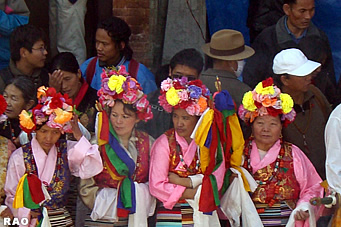 |
|
Traditionally, female representation at decision-making levels in the trade unions has been marginal and they have not accorded priority to women workers' issues (GEFONT, 2000). Although women have constituted a substantial proportion among their members, female representation among the executives had been only marginal in the past.
Currently, women constitute about 12 percent of the total central leadership in the three largest unions. The larger trade unions have also taken specific policy decisions for increasing quantitative and qualitative representation of women in their activities and decision-making positions.
In spite of their overwhelming concentration on party-politics, trade unions have usually fought for specific rights for women workers for fulfilling their mothering roles. Their demand lists have included maternity leave, equal wages, crèche facilities, provision of female toilets etc, which have enabled women workers to legally establish such rights. The Labor Act together with Labor Regulations (1993) has provisions of 52 days of paid maternity leave up to two pregnancies, only day time employment, limitation on the loads larger than their own body weight etc. At the work places employing more than 50 women, provisions have been made for compulsory crèche facilities and female toilets.
![]() Lack of gender perspective in union leadership, policies and programs.
Lack of gender perspective in union leadership, policies and programs.
![]() Low priority to women worker-specific issue in collective bargaining. Although
some of the women-specific issues have been raised they have not been a
priority in collective bargaining.
Low priority to women worker-specific issue in collective bargaining. Although
some of the women-specific issues have been raised they have not been a
priority in collective bargaining.
![]() Lack of emphasis on development and continuity of women's participation
and leadership, focus on "participation" and "representation" only.
Lack of emphasis on development and continuity of women's participation
and leadership, focus on "participation" and "representation" only.
![]() Patriarchal environment in the unions, e.g., insensitivity to women's needs
in organisational matters (fixing union activities, time, venue etc), lack
of cooperation, encourage-ment and support to women in the union work,
no major responsibility to women etc.
Patriarchal environment in the unions, e.g., insensitivity to women's needs
in organisational matters (fixing union activities, time, venue etc), lack
of cooperation, encourage-ment and support to women in the union work,
no major responsibility to women etc.
![]() Unequal employment opportunities.
Unequal employment opportunities.
![]() Sexual harassment of women even in the unions.
Sexual harassment of women even in the unions.
![]() Absence of clear laws and regulations to define sexual harassment at the
workplace; often little action against such harassments and lack of appropriate
treatment and indemnity to the victims
Absence of clear laws and regulations to define sexual harassment at the
workplace; often little action against such harassments and lack of appropriate
treatment and indemnity to the victims
![]() Lack of recognition of family responsibilities in the workplace.
Lack of recognition of family responsibilities in the workplace.
Consequently, women workers have identified awareness and education campaigns against sexual harassment, on female workers' demands, on HIV/AIDS and building transparent work place and women's confidences as their priorities.
Media
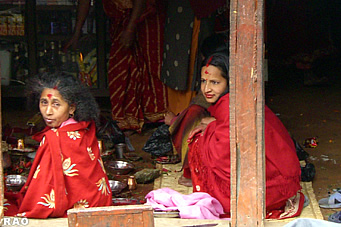 |
|
At that time the sole electronic media were Nepal Radio and Nepal TV. With the proliferation of FM radios and private TV channels, women's participation as media workers has increased significantly in 2002 as reflected in the table below.
Similarly, there has been a substantial progress in the media coverage of women's issues (Asmita Publishing House, 2003).
These positive developments, nevertheless, have not been accompanied by a changed attitude towards a need for inducting women in this sector by social consciousness for promoting women, but for commercial gains only as accepted by the management in interviews (Asmita, 2003). Most of them use women for promoting consumer products, thus propagating the capitalist image of women merely as consumers and reinforcing gender subordination in a new form. Women's issues are trivialized. For example, in one of the furniture advertisement on Classic FM the wife says that she will not ask for divorce, since the husband has bought the furniture of her choice.
For women divorce is a question of life and death. Media should have an adequate sensitivity to reject advertisements degrading women. Most adver-tisements promote commoditification of the human body. The print media may be considered somewhat better than electronic media in this context. Nevertheless, most of them are guided by particular political and patriarchal ideology and perceptions. Otherwise, one would not have seen irrelevant naked females even in government papers like The Rising Nepal or the private sector Samachar Patra daily, as a perceived marketing ploy.
The
next most important issue is:
they picture male and female in all their presentations. Media is the most important channel which plays a crucial role in forming consciousness, attitudes, and behavior standards in the society. Do they idealize and perpetuate the traditional image of women or try to grasp the changing positive images of women?
Most
often, the articles and arguments made through media against change in
favor of women dwell on the personalities who are raising this issue rather
than the merit or demerit of the issue per se. For example, women who are
fighting for equal gender rights are pictured as greedy, foreign-instigated,
and with no knowledge of rural or ordinary women's lives. Even those people
who are struggling for democratic and human rights consider women's struggle
for legal equality irrelevant. When arguments are made on the issue per
se, it is possible to present counter-arguments and media have to treat
equal by both viewpoints. But when the attack is made on personal grounds,
such writings must be rejected, unless they are specific and verified.
Finally the language, cartoons, idioms, fables, and stories used to make their point in all presentations are mostly gender-biased. The mode of news presentation itself is another issue. For example, how is a rape case presented as a social crime for which the society must be ashamed or a sensation to sell the paper, blaming the victim for the crime? Both the males and females are cultural products, with their ideas and behavior shaped by the prevailing ideology, social mores, and behavioral standards of patriarchy.
The ideology of male and female is ingrained in our subconscious state, by our upbringing. We use language and figures degrading women subconsciously. A very revealing example of this was the "Chura and Pote" sent by the women demonstrators during the 1990 democratic movement to their male colleagues. Women political activists, with a long standing history of political struggle behind them, could not perceive the degradation of their own history and contributions to the democratic movement implied in this act.
Similarly, the writings of most respected proponents of change also still clearly reflect their gender bias. For example, take the following passage: " Ahile RAPRAPA bhaneko Kangress ka lagi gharania paribar bata bhitriaeki sahrai mukhale dulahi jasti bhai raheki cha'daijo samet laieki dulahi'randi RAPRAPA'kada bachan bolda budheshkal ki kanchi ratarat poila jane khatara cha " (Khagendra Sangraula, Sapatahik Jana Astha, Kartik 15, 2052 as recited by Asmita, 2002 ). This Asmita publication cites enume-rable examples of the use of such idioms and language by our so called progressive and not so progressive writers. The writers and media presenters must be aware of their own language and ideology.
Thus, increasing gender consciousness among the reporters, writers, and news handlers about the content, language, and modality of presentation is identified as the major challenge in this sector.
Research
Institutions
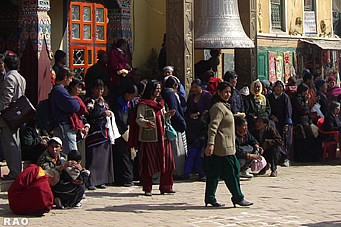 |
|
It has been well established by now that the structural adjustment policies, promoting a competitive economy through privati-zation and a minimalist state, is neither poor-friendly nor gender-friendly in general (HDR, 1996).
This has been proved by the political commotions, which have resulted partially from such policies all over the world during the last decade. The poor and the politically, socially, and economically weaker sections of the population, who form the majority in the developing countries, can hardly compete in this unequal global race. However, the research studies on impact of such policies in Nepal have generally failed to explore such issues as an integral part of their research, particularly in reference to women.
The structural adjustment programs have included: (i) expenditure control, streamlining of transfer and subsidies, and shift in budgetary allocations; (ii) privatization and commercial orientation of public enterprises including utilities; (iii) privatiza-tion or decontrol of delivery of basic services or move towards cost pricing of such services; and (iv) rationalization of tax structure. These measures are further accompanied by deregulation of the internal and the external sectors. All these measures have impor-tant implications for women's access to resources, necessary services, and employment, but few macro-economic researchers have paid attention to them (for detailed discussion, sees Acharya, 2003 and Rai, 2002).
Expenditure control, streamlining of transfer and subsidies, and shift in budgetary allocations has been one of the major policies under fiscal reform. It is good for the whole population if the expenditure control is achieved by maintaining the minimum level of development expenditure required for physical and social infrastructure and assisting the weaker sections of the population to cope with the vagaries of globalization. But, in Nepal, development expenditure as a proportion of GDP has declined during the nineties.
On the positive side, the pattern of expenditure has shifted in favor of social and human priority sectors and rural infrastructure. Within the social sector, budget allocation to human priority sector, which is defined to include primary health care, basic and non-formal education, rural water supply, essential family plann-ing services and nutrition programs, bears a great significance in terms of making basic social services available for women and the poor. This is because the use of household resources is biased against women due to the patriarchal structure and value system; women have to use mostly public services. The absolute amount of expenditure per head on such items has also increased.
The shift in budgetary allocations towards development of rural physical infrastructure and social sectors, such as education, health and drinking water could be women-friendly if supplemented by social mobilization of women to benefit from such development. Since the poor women live mostly in rural areas, building of rural infrastructure can increase the access of women to sources of employment and markets. But such developments could also open up the rural economy and the women to global competition, whereby they might not be able to compete. They need specific enabling programs such as education, technical skill training, and access to information to be able to compete. All this needs careful sequencing of the policies and programs, which has not been in evidence until recently in Nepal.
Generally, a shift in allocation pattern involves reducing expenditure on economic services. Whether streamlining transfers and reduction in subsidies is beneficial or harmful to women will depend on the specific items of subsidy reduced and use of resources thus freed. Withdrawal of subsidies like those extended to small irrigation, biogas, food, livestock insurance, credit to small farmers etc., have significant productive as well as distributive effect. Such cuts may reduce the profitability of agriculture hence reducing employment opportunities for rural women. This is in evidence in Nepal (see Acharya, 2000).
In Nepal the withdrawal of price subsidy on food and fertilizer has crippled the food security system and exposed households in the remote and other food deficit areas to hunger and malnutrition. The deteriorating food security situation has led to increased labor migration in search of employment and income. As increasing number of men leave the villages, many more families have to remain separated from their working age male members. This has increased family responsibilities of women, who in the absence of their male counterparts have to bear the burnt of hardship. It has become easier for the traffickers to lure women and their families with the hope of bright future as they struggle to fulfill their basic needs.
Transfers
to university education, central hospitals, media/ communications, and
operation of public enterprises are of lesser importance from the viewpoint
of benefiting poor women. Never-theless, reduction in such transfers does
have adverse gender implications, as it reduces women's access to such
services, given that women in general have less access to household resources
to meet their own needs. This aspect also remains unexplored in Nepal.
Privatization and Commercial Orientation of Public Enter-prises (PE):
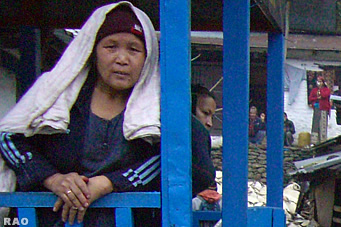 |
|
The first-hand impact of privatization of public enterprises is not gender-friendly in general. Privatization generally results in increase in the prices of the products of the privatized enterprises, whose impact on women as consumers depends on importance of this product in the family budget of an average and poor family.
It constrains the household budget and hence puts more pressure on the poor women. The primary impact of such privatization is reduction in female employment forcing them to work on unequal terms. The studies on impact of privatization do not even provide gender disaggregated employment data.
Once privatized, government has less ability to ensure that the services reach the poorest and most difficult to reach areas. They are usually the most expensive to reach, which means that the profit motive will lead private companies to ignore them.
Moreover, privatization transfers public property usually to male population, because women have no resources to buy them in the first place and hence this creates more disparity in access to resources.
Privatization or decontrol of delivery of basic services or move towards cost pricing of such service: Privatization of delivery of social services and imposition of fees may reduce women's access to such services further in societies, where women face severe discrimination in the access to family resources. In many surveys, the most recent ones being the NLSS (1995/96) NMIS, 1996), the direct cost of education has been cited as one of the hampering factors in sending girls to school, in addition to the need to marry them off and housework. The increase in education cost must have hampered girl's education further. Most of the studies on privatization of education have ignored this issue. Privatization of basic services without a mechanism in place to enable the common people to benefit from such privatization and proper regulatory mechanisms often widens further existing social cleavages in already divided societies. The current commotion on the educational front in Nepal is a direct result of such privati-zation policies, without a proper regulatory and compensatory mechanism.
Rationalization of tax structure: Rationalization of tax structure has generally meant increase in direct tax burden but reduc-tion in commodity taxation. But in the recent years, reduction in tax rates have become a common phenomenon. The primary objectives of tax reform have been promotion of the private sector through fiscal incentives and opening the market for competition by reducing tariff to comply with the WTO requirements.
The
direct tax system in general has less relevance for women directly because
women are mostly outside such tax net. The differential impact of indirect
tax on gender is more pronounced. Across the board, women are generally
poorer than men. Indirect taxes, which tend to discriminate against the
poor, are therefore likely to be more discriminatory against women. Introduction
of VAT and reduction in tariff slabs and a general reduction in the rates
has made the indirect tax system more regressive in Nepal during the 1990s.
Customs or tariff measures affect women as a worker, a farmer, a consumer or a trader. The drastic cut in tariff wall in Nepal in the nineties bringing down the average import duty to 10 per cent at present against more than 25 per cent a decade back has reduced the protection for industries sharply. As a result, many labor-intensive industries like cottage and small-scale manufac-turing in the informal sector, textile, and other import substitution industries have been forced to close down. This has eroded the job opportunity and off farm activities of women in the rural areas.
The job opportunities created in the urban areas, driven by the forces of export market, remain highly uncertain due to vulnerability of the exports market. There is no job security, nor adequate coverage in terms of social protection. The participation of women in formal sector job is often limited and there are few women entrepreneurs. On the whole, women may not have benefited from the growth of the private sector propelled by fiscal incentives (see Acharya, 2000b), except in a few cases.
On the other hand, women could have benefited as consumers by the reduction on tariff rates on essential goods, particularly food and medicine.
The issue is not whether Nepal should have implemented the structural adjustment policies, but whether the group-specific likely impacts on the people were taken into account while implanting such policies. The government and the assisting research institutions in Nepal have generally failed to analyze these aspects. The challenge is to make the process of integration in the global economy more gender-sensitive and human.
Given the limitation on
available resources, and generally low level of living standards of the
majority of the population, the possibility of the capture of resources
by the powerful groups is immense, which has bogged down the whole governance
process. Women and the poor have figured only as pawns in this power game.
Researchers must be aware of these implications and advise the government
on appropriate compensating policies and programs.
 |
| IV Changing Gender Status -Achievements and Challenges |
|
|
The efforts at promotion of women by the government/donor sector and selected segments of the civil society were reviewed in brief in the last section. Their problems were also discussed briefly. The issue is how have all these programs and activities impacted on gender relations, and women's status in comparison to men's status in general? Have they been able to make a dent into the entrenched patriarchy? Or is patriarchy just changing its face?
As discussed above, patriarchy is an all-involving ideology, which permeates all aspects of life, whereby the coordinates of subordination reinforce each other. For example, in Nepal the social disadvantages of women due to early marriage, high fertility and low access to health and family planning services, and low educational levels and violence against them are reinforced by lack of access to economic resources. Both of which are reinforced by the political powerlessness, which in its turn reinforces other inequities. Social disadvantages in their turn debar women from active participation in politics. The following analysis, therefore, proceeds in the background of this circular relationship. Although, for analytical purposes, the impact on gender relations has been examined under the social, economic, and political dimensions, the inter-relation between them is kept always in the background.
Social
Status
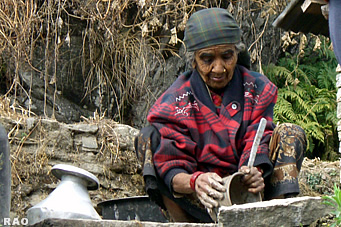 |
|
The mean age of first marriage for both the girls and the boys is increasing.
Female
literacy has increased from 12 percent in 1981 to 42 percent in 2001. The
number of literate women per 100 literate men has reached 65 in 2001 from
34 in 1981.
Yet,
the ideology of male domination, which pervades our lives, is changing
only slowly and is hampering development in all sectors. It is well recognized
by now that there is a large variation between the Indo-Aryan and the Tibeto-Burman
groups and even within each of these groups, in terms of the social relations
governing gender relations. In spite of this diversity, land is inherited
universally in all communities from the father to the son and women lag
far behind men in access to knowledge, economic resources, and modern avenues
of employment. Marriage is compulsory, seen as a primary means of livelihood
for women in all most all communities (Acharya and Bennett, 1981; Gurung,
1999).
In comparative analysis, only women's life expectancy seems to indicate a significant progress towards gender equity. In literacy and education, gender disparities are decreasing only slowly. Girl's enrolment has not attended parity even at the primary level. The number of women with School Leaving Certificate (SLC) and higher degrees still constitute only 43 for every 100 men with such qualifications. Similarly, the number of women, with graduate and higher degrees, is still only 23 to 100 men with such degrees. What is more, this ratio has increased only marginally compared to the 1991 figure of 22.5. The female\male ratio of full-time students is still only 43:57. Further, these achievements are very unequally distributed as between the regions, rural and urban areas, among the castes and various ethnic groups.
Violence against women is also widespread in all the commu-nities. Violence, both in the domestic and in the public arena, is still used extensively by the patriarchy to establish domination over women. Ninety-five percent of the women surveyed in one study (Sathi et all, 1997) reported first-hand knowledge of some kind of violence against women. The form of violence ranges from mental torture to mild beating to extreme selling and trafficking for commercial sex work.
As per the 2001 Census, more than five hundred fifty-five thousand women are living in polygamous marriage relationship. Alcohol and polygamy-related violence in the domestic arena is reported high all over Nepal and across all communities (New ERA, 1998). Dowry-related violence was reported to a lesser extent, but it does exist. A large group of young widows, particularly in the Indo-Aryan community, are subject to covert and overt violence and face both psychological (as forerunners of misfortune) and physical violence, often for her share of property.
Trafficking is widely reported but hard data are impossible to collect. Police estimate trafficking of about 5000-7000 women for commercial sex work annually. In the past, girls and women from the Tibeto-Burman groups, coming from poor rural areas were prone to trafficking. But in recent years, this malice is spreading all over the country and girls from all communities are falling victim to this heinous crime. Younger girls are being lured to this trade, overtly or covertly (New ERA, 1998).
Poverty and lack of adequa-tely paying jobs, due to progressive decline in demands for the services of the village craftsmen and accelerated impoverishment of lower peasantry due to land division and subdivision, is pushing households to sell their own girls. Modern consumerism and drug use among the youngsters have made it easier for the traffickers to lure young women even from the middle class. The patriarchal socialization, which establishes marriage as the most respectable livelihood option for the girls, is one of the causes of girls falling to the trap. The Maoist insurgency has further compounded the problem of violence against women and children.
 |
Economic Status
On the economic side, women's participation in formally defined labor force has increased substantially between 1981 and 2001. Many of the definitional problems in the economic activity rates are also being taken care of slowly. As per the Census, 2001 women constitute almost 43 percent of the labor force, 48 percent in agriculture, and 34 percent in the non-agriculture sector. This increase is accounted for by three factors: increase in actual participation defined as economic, redefinition of the activities themselves, and more detailed and specific description activities in the Census manual and training.
All these factors are positive from the perspective of women's empowerment, but beyond the scope of this paper for detailed discussion. They contribute to making women's work visible. But the subsistence sector is getting feminized, and this is not favorable from a gender perspective. It means further segregation of women to low paying activity.
The development of major export industries, such as carpet, garments, and woolen goods, has opened new avenues of formal employment for women. The proportion of women in the non-agricultural work force has increased to 34 percent. However, here also women are concentrated at low paying and less productive, low capital intensive jobs (NLFS, 1999). Most of the labor regula-tions are side-tracked by employing women at piece rates (GDS\ FES, 1997; GEFONT, 2003). Overall women earn about 4/5th of what men earn in agriculture, but 3/4th outside of agriculture as daily wages (NLSS, 1995/96).
A substantial proportion of women are confined to household work due to social and reproductive reasons. Even if the home-making activities, such as household maintenance and child-care, do not fall within the production boundary defined by the System of National Accounts (UN, 1993) currently, such activities never-theless are necessary for human reproduction and no economy can survive without them. Therefore a comparison of working and not-working population is also useful for an analysis of livelihood patterns.
The category of workforce in the above table includes all working population, irrespective of the kind of work they do. Any person engaged solely in home-making is also considered working. Work is defined as an activity, which a second person can do for you, for example cooking, taking care of children, cleaning, washing - all activities in the household maintenance and child-care. Only activities, which a second person can not do for you, for example, sleeping, taking care of your own person, watching TV, study etc, are excluded from the definition of work.
Overall and among most age-cohorts,
larger proportions of women were working than men, as per this definition.
In totality, 66.5 percent of male and 72.4 percent of the female population
were working in 2001, while slightly more than 90 percent of men and women
in the 25-54 age group population were working, the difference was only
in the kind of work they did. Of the total workforce, 52 percent were women,
while among the home makers they constituted almost 95 percent (see Acharya,
forthcoming).
As to the access of women to economic assets and property, there is no ground to believe that women's access to land and other economic resources has increased in the last 20-25 years as their legal rights over property and inheritance has not changed much during this period. Even the recently promulgated amendment to the law on property rights of women does not change her access to parental property substantially. The law, how-ever, does provide easier access to property in her afinal household. As per the Census 2001, about 11 percent of the households reported some land in female legal ownership.
Similarly, only 5.5 percent of the households had some house in women's name. Only 7.2 percent households reported female livestock ownership does in spite multiple credit-institutions targeting and funding this activity for women. In spite of various credit programs, women's access to institutional credit remains marginal, both at individual and household enterprise levels irrespective of ecological regions, urban/rural areas and ethnicity/ caste (Acharya, 2002). Only 0.8 percent of the households had all three, house, land, and livestock in female ownership. Almost 83 percent of the households had no property, whatsoever, under women's legal ownership. Women get only half the earned income of what men get, in terms of purchasing power parity.
Female-headed
households, which constituted about 15 percent of the total households,
owned smaller landholdings than the male-headed ones. Compared to male
heads, female heads of the households were educationally much more disadvantaged.
Political Status
Women's access to the positions of power, political or otherwise, has not improved much in the last 10-15 years except at the grassroots level, although the constitution reserves five percent of the seats among the candidates of political parties in parliamentary elections for women. At the grassroots level only, the 20 percent reservation by the Local Self-Governance Act 1999 has made a difference.
In the parliamentary elections, political parties have not been able to put up more than the required mandatory five percent female candidates. Further, the constituencies allocated to women candidates have often been those, which the particular party considered difficult to win. As a consequence, in the outgoing House of Representatives women constituted less than 6 percent, although their proportion was much higher in the Upper House, where the members are either nominated by the King or get elected on the basis of party strength in the Lower House.
The cabinets formed in the last decade have never included more than two women or have been given important positions to them, barring one or two exceptional cases. One female member in 20-45 ministers has been the rule. Still, today women constitute less than 10 percent in the Central Committees of the major political parties.
Only reservation since 1997 has been able to bring out women into politics in significant proportions, 20 percent at the grassroots level. Still in the DDC Council women constitute only 1.5 percent even with the mandatory nominations. The higher the position, the lower is the female representation. Moreover, the system of nominating women in the Local Self-Government (LSG) executive bodies is incompatible with the general process of LSG structure. They should be elected as other members in all the related LSG institutions.
Female representation in government administration is also improving, but only slowly. Compared to 1978, the proportion of women in the government administration has almost trebled. At the officer and higher levels it has doubled. Still women constitute less than ten percent of the total government staff. The proportion of women even among the professional and technical group in the occupational classification had declined in 1991, compared to 1981 but the trend has fortunately reversed as per the 2001 Census. The trend of increasing proportion of women in administration and management is more encouraging.
During the 1990s, women's awareness of political and gender issue has increased rapidly. Although there are no macro-level data to authenticate the above statement, women have been mobilized extensively into groups by various NGOs/INGOs and the government programs. After the mandatory provision in LSGA 1999, they have also been mobilized by the political parties for participation.
Women's political consciousness is also increasing. The pro-portion of rural women who knew about women's organisations had more than trebled between 1978 and 1992 (from 4.7 percent to 14.9). But still, only 15 percent of the rural women knew about women's organisations and less than one percent participated in them. Slightly more than 20 percent knew about the new constitution, but only 6.2 percent was aware of its discriminatory features.
Awareness in urban areas was higher (Acharya, 1997) at 29.2 percent. In contrast to one percent women reporting any women's organisation membership, a recent survey conducted by GEFONT among women/men workers reports (GEFONT, 2003) that 27 percent of the women workers interviewed had ever joined one or other woman's organisation. But many of these women also reported that they could not continue such membership due to familial and social non-acceptability and household responsibilities.
The usual defect of reservation that it becomes only a token gesture and women actually do not participate effectively has not been supported by the five years experience of reservation for women in LSG in Nepal (UNDP, 1998). Social and political changes are clearly visible:
![]() In spite of the socio-economic constraints, many women representatives
have participated effectively in LSG affairs and have been able to influence
the decision-making process.
In spite of the socio-economic constraints, many women representatives
have participated effectively in LSG affairs and have been able to influence
the decision-making process.
![]() They have been able to draw attention of their colleagues to the issues
of basic needs and community development as also women's development.
They have been able to draw attention of their colleagues to the issues
of basic needs and community development as also women's development.
![]() They are also fighting against the burning gender issues such as alcoholism
and violence against women, including trafficking.
They are also fighting against the burning gender issues such as alcoholism
and violence against women, including trafficking.
![]() Slowly women's leadership is emerging from the grassroots level. Their
quest and assertion for power sharing, resour-ces, and authority is itself
a process of their empowerment.
Slowly women's leadership is emerging from the grassroots level. Their
quest and assertion for power sharing, resour-ces, and authority is itself
a process of their empowerment.
![]() These women educated in grassroots politics and gender issues will create
a political force in favor of women. LSG Women Representatives' Federation
with a comprehensive action plan for social change will be a force, which
the political parties will have to reckon to.
These women educated in grassroots politics and gender issues will create
a political force in favor of women. LSG Women Representatives' Federation
with a comprehensive action plan for social change will be a force, which
the political parties will have to reckon to.
![]() The emergence of a large number of underprivileged women in local government
heralds a fundamental change in the socio-economic position of the Dalits
as well.
The emergence of a large number of underprivileged women in local government
heralds a fundamental change in the socio-economic position of the Dalits
as well.
| V Conclusions |
|
|
Thus much of the problems with women's advancement are now related to patriarchal ideology, behavior, and structures. All the sectors/ sub-sectors discussed above are hampered in achievement of their objectives by a patriarchal ideology and structures.
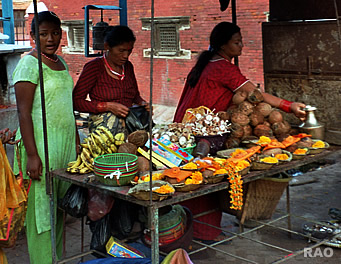 |
|
HMG has already made improvement in women's status as one of its major policy objectives along with poverty reduction. Nevertheless its implementation remains a challenge, due to the patriarchal value systems and structures. For example, credit programs can effect only marginal improvement in women's economic status, because they have little property to pledge to venture in larger enterprises than micro-credit-funded micro-establishments. Unmarried girls are debarred even from this micro-credit in actual practice because after marriage they have to leave the natal household and lose the right to property in the natal household and credit institutions have difficulty recovering their loans.
Girls have much less access to education beyond school level because they have to be married off early to get good husbands. Old women have difficulty getting old-age and widow allowances because they have difficulty proving their citizenship, as citizenship certificates can be obtained only after establishing their husbands' or fathers' Nepalese identity.
As far as equality in access to resources, decision-making positions and powers, and socially accepted ideology is concerned, any change that has taken place has been accidental. There is no general recognition that unless women are recognized as full citizens at par with men, the development process cannot proceed rapidly. The basic challenge therefore is how to change the patriarchal structures and ideology, which are interdependent and viciously reinforcing each other.
In
the three civil society sections discussed above-trade unions, media, and
research institutions, a need for attitudinal changes towards gender issues
was identified as a basic necessity for further advancement of women. It
seems that without attitu-dinal and ideological change, further structural
reforms in favor of women will be hard to achieve.
The impact of patriarchy on our ideas, behavior, and convic-tions can be reduced only by a multi-dimensional and concerted effort first and foremost after re-examination of our value systems, behavior, and attitude toward issues raised by the women's move-ment. Patriarchy in the Nepalese society is manifested essentially in legal structures, e.g., tying women's property rights with marriage and the ideology of compulsion of marriage and shift of a girl to afinal household in marriage, control over her sexuality, and the need for having sons for salvation.
The relationship is circular. This hampers women's access to resources and avenues of employ-ment, health facilities, and education and knowledge, which in its turn makes women more dependent on men for access to resour-ces. In the light of the discussions above, the exercise for FES partners should start with examination by themselves of their institutions, objectives, and guiding principles in a gender perspective.
The Task ahead for FES/Nepal
In the past, FES has funded activities separately for women in various sectors, such as education, media, trade unions, Municipal Federation of Nepal (MuAN) etc. NGOs particularly focused on gender, such as Legal Aid and Consultancy Center (LACC), Central Department of Home Science, Women's Studies Program, and Sancharika Samuha have been its important partners. But its collaboration with other major partners, particularly trade unions, research institutions, and media has not been examined through a gender lens. Currently, FES has set itself an objective of gender mainstreaming in all its programs (2003). Naturally, FES/ Nepal has a task of ensuring that all its future funding is put through a prism of gender sensitivity. In this context, FES may adopt the following criteria for examining the project proposals:
![]() Does
the proposed project intend to address the related gender issues as an
integral part of the research or program to be implemented?
Does
the proposed project intend to address the related gender issues as an
integral part of the research or program to be implemented?
![]() Is there a gender balance among the participant numbers or staffing for
the proposed program?
Is there a gender balance among the participant numbers or staffing for
the proposed program?
![]() Do the partners understand the gender issue properly and have positive
attitudes towards changes in favor of women's equality and equity for them?
Do the partners understand the gender issue properly and have positive
attitudes towards changes in favor of women's equality and equity for them?
![]() Are the changes recommended for making the project/ program more gender-sensitive
acceptable to the proposed partner?
Are the changes recommended for making the project/ program more gender-sensitive
acceptable to the proposed partner?
| References |
|
|
Acharya,
Meena (2004, forthcoming), "Changing Gender Status ?Achievements and Challenges"
in Monograph on Population Census 2001, CBS, Kathmandu.
Acharya,
Meena (2003), Gender Budget Audit in Nepal, UNIFEM/ New Delhi.
Acharya,
Meena (2000), Labor Market Developments and Poverty: with Focus on Economic
Opportunities for women, Katmandu: Tanka Prasad Memorial Foundation and
Friedrich-Ebert-Stiftung.
Acharya,
Meena (1997a) (With Pushpa Acharya), Gender Equality and Empowerment of
Women, A Status Report, UNFPA, Kathmandu.
Acharya,
Meena and Lynn Bennett (1981), An Aggregate Analysis and Summary of 8 Village
Studies. The Status of Women in Nepal. Vol. II, Part 9. CEDA, Kathmandu.
Asmita
Publishing House (2002), Patrakarita ma Mahila Prashna (Nepali).
Bhasin,
Kamla(2000), Understanding Gender. Kali for Women: New Delhi.
Bhasin,
Kamla and Nighat Said Khan. (1991), Some Questions on Feminism. Kali for
Women: New Delhi.
Batliwala,
Srilata (1994), Women's Empowerment in South Asia: Concepts and Practices
FAO/ Asian-South Pacific Bureau of Adult Education , New Delhi.
Central
Bureau of Statistics, (1995), Population Monograph of Nepal, Kathmandu.
............./NPC/HMG,
(1996) Nepal Living Standards Survey, 1995/96. Main Findings, Vols. I.
& II. Kathmandu.
Engels,
Fredrich (1891), The Origin of the Family, Private Property and the State,
Reprint International Publishers, New York, 1972.
GDS\FES
(1997), Women in Garment Industries, Kathmandu.
GEFONT
(2001), Woman Participation in Nepali Labor Movement, Kathmandu.
-------(2003),
Search for Alternatives, Kathmandu.
Gurung,
Jeannette, D. (1999) (ed.), Searching for Women's Voices in the Hindu Kush
Himalayas , ICIMOD, Kathmandu.
Kabeer,
Naila and Ramya Subrahmanian (1999), Institutions, Relations and Outcomes,
Kali for Women, New Delhi.
Krishnaraj, "Coributions to Women Studies Series -7, Feminist Concepts, Part
I & II.
HMG\N
(1997), Local Self-Governance Act, 1997, Kathmandu.
INSEC
(2002), Human Rights Report, Kathmandu.
HMG\N
(1997), Local Self-Governance Act, 1997, Kathmandu.
INSEC
(2002), Human Rights Report, Kathmandu.
Manandhar
Laxmi Keshari and Krishna B. Bhattachan eds. (2001), Gender and Democracy
in Nepal Central Department of Home Science, Women's Studies Program and
FES/Nepal, Kathmandu.
National
Planning Commission/HMG, Sixth Five Year to Tenth Five Year Plans.
(1996),
Nepal Multiple Indicators Surveillance (NMIS): Primary Education
Second Cycle, April-June 1995.
New
ERA (1998), A Situation Analysis of Sex Work and Trafficking in Nepal with
Reference to Children, October 1996. Submitted to UNICEF, Nepal.
Rai,
Shirin M. (2002), Gender and Political Economy of Development, Polity Press,
Cambridge, UK.
SAATHI
and The Asia Foundation, (1997), A Situation Analysis of Violence against
Women and Girls in Nepal, Kathmandu.
Rosaldo
M. Z. and Lamphere L. (1974), Women, Culture and Society, Stanford University
Press, California.
Tong
Rosemarie (1989), Feminist Thought: A Comprehensive Introduction, Westview
Press, Boulder, USA.
United
Nations (1995, 2002), Human Development Report, New York.
United
Nations (1993), System of National Accounts, New York.
United
Nations (1995), The Beijing Platform for Action, New York.
UNDP
(1998): National Gender Analysis on Elected and Nominated Women Ward Representative,
Kathmandu.
Walter,
Viktoria (2003), Practising Gender: The Tool Book, Germany.
World
Bank (2001), Engendering Development through Gender Equality in Rights,
Resources and Voice, Washington D. C.
Bibliography
Acharya,
Meena ( 2001), "Changing Concepts of Well-being: Policy Implications for
Poverty Eradication in Nepal" A paper presented in the Conference on Sustainable
Develop-ment and Southern Realities : Past and Future in South Asia, organized
by the Sustainable Development Policy Institute, Islamabad, October 31-November
2.
Acharya,
Meena (2000a), "Quantification of Household Production and Gender aspects
in Nepal" in Household Accounting Experience in Concepts and Compilation,
UN Statistical Office, New York.
Acharya,
Meena (1994), "Statistical Profile of Nepalese women: An Update in the
Policy Context", Institute for Integrated Development Studies.
Acharya,
Meena (1994), "Political Participation of Women in Nepal in Women and Politics
Worldwide (ed.) by Barbara Nelson and Nazma Chowdhery, Yale University
Press, New Haven, London.
Acharya,
Meena (1986), "Changing Division of Labor and Participation" in James W.
Bjorkman (ed.)The Changing Division Of Labor in South Asia.Riverdale, Maryland:
Riverdale Company Publishers.
Acharya,
Meena and Lynn Bennett (1983), "Women and Subsistence Sector: Economic
Participation and Decision Making in Nepal", World Bank Working Paper series
526,Washington, D.C.
Bhatt,
N., L. Shrestha, B. T. Slayter & I. Koirala (1994), Managing Resources
in a Nepalese Village:Changing Dynamics of Gender, Caste and Ethnicity,
IIDS, Kathmandu.
Banerjee,
Nirmala (2002), What is Gender Budgeting? Paper presented in the Third
Regional Meeting on Gender Budget, 16-17 December, Kathmandu, Published
by UNIFEM/New Delhi.
Brettell,
Caroline and Carolyn Sargent (eds.). (1997), Gender in Cross-Cultural Perspective.
Prentice Hall: New Jersey.
Bennett,
Lynn (1983), Dangerous Wives and Sacred Sisters, Columbia University Press,
New York.
Boserup,
Easter (1970), Women's Role in Economic Development, George Allen and Unwin,
London.
Eisenstein,
Zillah R. (ed.) (1979), Capitalist Patriarchy and the Case for Socialist
Feminism, Monthly Review Press, New York
Hirsch,
Marianne and Evelyn Fox Keller (eds.) (1990), Conflicts in Feminism. Routledge:
New York.
Kabeer,
Naila and Ramya Subrahmanian (1999), Institutions, Relations and Outcomes,
Kali for Women, New Delhi.
Kabeer,
Naila (1994), Reversed Realities Kali for Women: Gender Hierarchies in
Development Thought, New Delhi.
Kemp,
Sandra and Judith Squires (eds.)(1997), Feminism Oxford: New York.
Krishnaraj,
M. and K. Chanana, (ed.) (1989), Gender and the Household Domain: Social
and Cultural Dimensions, Women and the Household Asia Vol. 4, Sage Publications,
New Delhi.
Manandhar,
Laxmi Keshari and Krishna B. Bhattachan (2001), Gender and Democracy in
Nepal, Central Department of Home Science, Women's Studies Program and
FES/Nepal, Kathmandu.
Meillassoux,
Claude (1981), Maidems, Meals and Money: Capitalism and Domestic Community,
Cambridge University Press, New York.
Moser,
Caroline O. (1993), Gender Planning and Develop-ment, Routledge, New York.
Nelson,
Barbara and Nazma Chaudhary (1994), Women and Politics Worldwide. Yale
University, New Haven, USA.
Rao
A, Anderson M.B. and C. A. Overholt, (ed.) (1991), Gender Analysis in Development
Planning, A Case Book, Kumarian Press.
Rogers,
Barbara (1980), The Domestication of Women, Tavistock Publications, London.
Saigol,
Rubina (1995), Knowledge and Identity: Articulation of Gender in Educational
Discourse in Pakistan, ASR Publication: Lahore.
Shtrii
Shakti (1995), Women, Development, Democracy: A study of the Socio-Economic
Change in the Status of Women in Nepal (1981-1993), New Delhi.
Stockard,
Jean and Miriam M. Johnson (1992), Sex and Gender in Society, Prentice
Hall, New Jersey.
Tuladhar,
Joyti (1996), Factors Affecting Women Entrepre-neurship in Small and Cottage
Industries in Nepal: Opportunities and Constraints, ILO and SIDA.
United
Nations (1995, 2002), Human Development Report, New York.
National
Planning Commission/HMG Sixth Five Year to Tenth Five Year Plans, Kathmandu.
----
(1996), Nepal Multiple Indicators Surveillance (NMIS), Primary Education
Second Cycle, April-June 1995.
UNIDO,
(1988), The Current and Prospective Contribution of Women in Nepal's Industrial
Development: Regional and Country Studies Branch, Industrial Policy and
Perspective Division.
| Credit:
Tanka Prasad Memorial Foundation, Friedrich-Ebert-Stiftung (FES) Kathmandu,
2006 © Tanka Prasad Acharya Foundation, 2003 |

|
| Document |
|
|
|
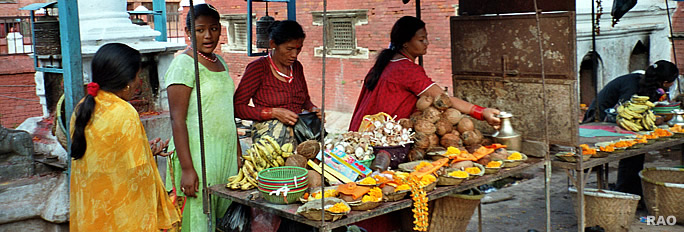 |